Regional Economic Development, Climate Change, and Work Force in a Gender Perspective in Chile: Insights from the Input–Output Matrix
Abstract
1. Introduction
2. Methodology and Data
2.1. Data
2.2. Methodology
3. Results
4. Conclusions
Author Contributions
Funding
Informed Consent Statement
Data Availability Statement
Acknowledgments
Conflicts of Interest
Appendix A
Appendix A.1. Ideal Results Compared with the Actual Results Presented in This Section 3
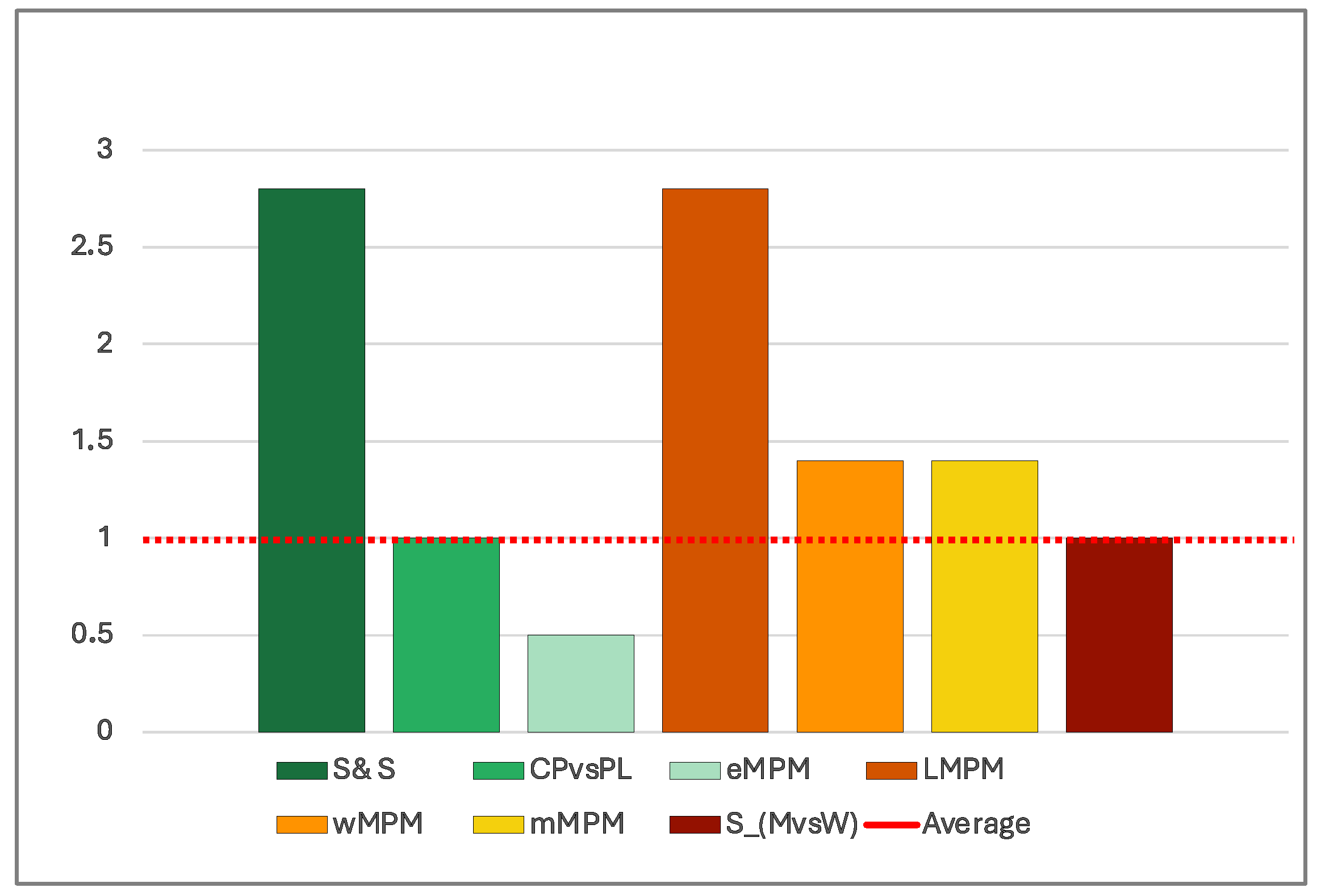
| S&S | CPvsLP | eMPM | LMPM | wMPM | mMPM | S (MvsW) | |
|---|---|---|---|---|---|---|---|
| Condition/Territory | >1 | ≈1 or [1.2–0.8] | <1 | >1 | >1& (wMPM ≈ mMPM) | >1& (wMPM ≈ mMPM) | ≈1 |
| Norte Grande | s02; s03; s05; s06 & s07 | s05 | s02; s03; s05 to s12 | - | s06 (no) & s1 (no) | - | s01 & s07 |
| Norte Chico | s02; s05; s06 & s07 | s05 | s02; s03; s05 to s12 | s01 & s03 | s01 (yes); s03 (yes); s06 (no); s11 (no) & s12 (no) | s03 (yes) | s01 & s04 |
| Central Zone | s03 & s07 | s03 & s05 | s02; s03; s05 to s12 | s01; s02 & s05 | s01 (no); s02 (no); s06 (no); s10 to s12 (no) | s01 (no); s02 (no) & s05 (no) | s03 & s04 |
| Patagonia | s01; s03 & s07 | s05 | s02; s03; s05 to s12 | s02 | s02 (no); s06 (no) & s11 (no) | s02 (no) | s01 |
Appendix A.2. Biplot Analysis (Principal Components Analysis)
| Axis | Eigenvalue | Expl. Var. | Cummulative |
|---|---|---|---|
| Axis 1 | 250.493 | 27.988 | 27.988 |
| Axis 2 | 203.562 | 22.744 | 50.732 |
| Axis 3 | 181.985 | 20.333 | 71.066 |
| Axis 4 | 152.272 | 17.014 | 88.079 |
| Axis 5 | 106.689 | 11.921 | 100 |
| Column | Axis 1 | Axis 2 | Axis 3 |
|---|---|---|---|
| S&-S | −7.296 | −0.43 | −9.465 |
| CPvsPL | 4.726 | 6.602 | −6.599 |
| eMPM | −4.584 | −9.295 | 1.468 |
| LMPM | −6.047 | 8.184 | 6.773 |
| S-MvsW | −10.833 | 2.535 | −0.906 |
| Column | Axis 1 | Axis 2 | Axis 3 |
|---|---|---|---|
| S&-S | 297 | 1 | 500 |
| CPvsPL | 125 | 243 | 243 |
| eMPM | 117 | 483 | 12 |
| LMPM | 204 | 374 | 256 |
| S-MvsW | 656 | 36 | 5 |
| Col | Label | Axis1 | Label | Axis2 | Label | Axis3 |
|---|---|---|---|---|---|---|
| 1 | S-MvsW | 656 | eMPM | 483 | S&-S | 500 |
| 2 | S&-S | 297 | LMPM | 374 | LMPM | 256 |
| 3 | LMPM | 204 | CPvsPL | 243 | CPvsPL | 243 |
| 4 | CPvsPL | 125 | S-MvsW | 36 | eMPM | 12 |
| 5 | eMPM | 117 | S&-S | 1 | S-MvsW | 5 |
| Col | Label | Axis1 | Axis2 | Axis3 |
|---|---|---|---|---|
| 1 | S&-S | 297 | 298 | 798 |
| 2 | CPvsPL | 125 | 368 | 611 |
| 3 | eMPM | 117 | 600 | 612 |
| 4 | LMPM | 204 | 578 | 834 |
| 5 | S-MvsW | 656 | 692 | 697 |
| Col | Label | Axis1 | Label | Axis2 | Label | Axis3 |
|---|---|---|---|---|---|---|
| 1 | S-MvsW | 656 | S-MvsW | 692 | LMPM | 834 |
| 2 | S&-S | 297 | eMPM | 600 | S&-S | 798 |
| 3 | LMPM | 204 | LMPM | 578 | S-MvsW | 697 |
| 4 | CPvsPL | 125 | CPvsPL | 368 | eMPM | 612 |
| 5 | eMPM | 117 | S&-S | 298 | CPvsPL | 611 |
References
- Sharifi, A.; Simangan, D.; Kaneko, S. Three decades of research on climate change and peace: A bibliometrics analysis. Sustain. Sci. 2021, 16, 1079–1095. [Google Scholar] [CrossRef]
- Doussoulin, J.P.; Mougenot, B. The Economic, Climate Change and Public Health Edges of the Geopolitics of COVID-19: An Exploratory Bibliometric Analysis. In Biotechnology to Combat COVID-19; IntechOpen: London, UK, 2021; ISBN 1-83968-627-8. [Google Scholar]
- Li, M.; Peng, M.Y.-P.; Nazar, R.; Ngozi Adeleye, B.; Shang, M.; Waqas, M. How does energy efficiency mitigate carbon emissions without reducing economic growth in post COVID-19 era. Front. Energy Res. 2022, 10, 832189. [Google Scholar] [CrossRef]
- Burgess, M.G.; Ritchie, J.; Shapland, J.; Pielke, R. IPCC baseline scenarios have over-projected CO2 emissions and economic growth. Environ. Res. Lett. 2020, 16, 014016. [Google Scholar] [CrossRef]
- Kais, S.; Sami, H. An econometric study of the impact of economic growth and energy use on carbon emissions: Panel data evidence from fifty eight countries. Renew. Sustain. Energy Rev. 2016, 59, 1101–1110. [Google Scholar] [CrossRef]
- Li, Z.; Huang, Z.; Su, Y. New media environment, environmental regulation and corporate green technology innovation: Evidence from China. Energy Econ. 2023, 119, 106545. [Google Scholar] [CrossRef]
- Córdova, C.; Zorio-Grima, A.; Merello, P. Carbon Emissions by South American Companies: Driving Factors for Reporting Decisions and Emissions Reduction. Sustainability 2018, 10, 2411. [Google Scholar] [CrossRef]
- Pinedo-López, J.; Baena-Navarro, R.; Durán-Rojas, N.; Díaz-Cogollo, L.; Farak-Flórez, L. Energy Transition in Colombia: An Implementation Proposal for SMEs. Sustainability 2024, 16, 7263. [Google Scholar] [CrossRef]
- Folini, D.; Friedl, A.; Kübler, F.; Scheidegger, S. The climate in climate economics. Rev. Econ. Stud. 2024, rdae011. [Google Scholar] [CrossRef]
- Nordhaus, W.D. A review of the Stern review on the economics of climate change. J. Econ. Lit. 2007, 45, 686–702. [Google Scholar] [CrossRef]
- Ribeiro, V.M. Green bond market boom: Did environmental, social and governance criteria play a role in reducing health-related uncertainty? Green Financ. 2023, 5, 18–67. [Google Scholar] [CrossRef]
- Leontief, W.W. Quantitative Input and Output Relations in the Economic Systems of the United States. Rev. Econ. Stat. 1936, 18, 105–125. [Google Scholar] [CrossRef]
- He, H.; Gao, Y.; Wang, X. Applying the Hypothetical Extraction Method to Investigate Intersectoral Carbon Emission Linkages of China’s Transportation Sector. Sustainability 2024, 16, 4046. [Google Scholar] [CrossRef]
- Doussoulin, J.P.; Bittencourt, M. How effective is the construction sector in promoting the circular economy in Brazil and France?: A waste input-output analysis. Struct. Change Econ. Dyn. 2022, 60, 47–58. [Google Scholar] [CrossRef]
- Leontief, W. Technological advance, economic growth, and the distribution of income. Popul. Dev. Rev. 1983, 9, 403–410. [Google Scholar] [CrossRef]
- Leontief, W. Machines and man. Sci. Am. 1952, 187, 150–164. [Google Scholar] [CrossRef]
- Leontief, W.; Duchin, F. The Future Impact of Automation on Workers; Oxford University Press: New York, NY, USA, 1986; ISBN 0-19-503623-9. [Google Scholar]
- Rifkin, J. The End of Work; G. P. Putnam’s Sons: New York, NY, USA, 1995; ISBN 0-87477-824-7. [Google Scholar]
- Fleming, P. Robots and organization studies: Why robots might not want to steal your job. Organ. Stud. 2019, 40, 23–38. [Google Scholar] [CrossRef]
- Andrew, R.M.; Peters, G.P. A multi-region input–output table based on the global trade analysis project database (GTAP-MRIO). Econ. Syst. Res. 2013, 25, 99–121. [Google Scholar] [CrossRef]
- Peters, G.P.; Andrew, R.; Lennox, J. Constructing an environmentally-extended multi-regional input–output table using the GTAP database. Econ. Syst. Res. 2011, 23, 131–152. [Google Scholar] [CrossRef]
- Huang, C.; Zhang, Z.; Li, N.; Liu, Y.; Chen, X.; Liu, F. Estimating economic impacts from future energy demand changes due to climate change and economic development in China. J. Clean. Prod. 2021, 311, 127576. [Google Scholar] [CrossRef]
- de la Rúa, C.; Lechón, Y. An integrated Multi-Regional Input-Output (MRIO) Analysis of miscanthus biomass production in France: Socio-economic and climate change consequences. Biomass Bioenergy 2016, 94, 21–30. [Google Scholar] [CrossRef]
- Wiedmann, T.; Barrett, J. Policy-relevant applications of environmentally extended MRIO databases–experiences from the UK. Econ. Syst. Res. 2013, 25, 143–156. [Google Scholar] [CrossRef]
- Sonis, M.; Guilhoto, J.; Hewings, G.J.; Martins, E. Linkages, key sectors and structural change: Some new perspectives. Dev. Econ. 1995, 32, 233–270. [Google Scholar]
- Sonis, M.; Hewings, G.J.D.; Miyazawa, K. Synergetic interactions within the pair-wise hierarchy of economic linkages sub-systems. Hitotsubashi J. Econ. 1997, 38, 183–199. [Google Scholar]
- Soza-Amigo, S.; Aroca, P. Productive structures and development: The case of the Chilean economy. Rev. Metodos Cuantitativos Econ. Empresa 2018, 26, 175–202. [Google Scholar] [CrossRef]
- Pyatt, G.; Round, J.I. Accounting and fixed price multipliers in a social accounting matrix framework. Econ. J. 1979, 89, 850–873. [Google Scholar] [CrossRef]
- Sonis, M.; Hewings, G.J. New Developments in Input-Output Analysis: Fields of Influence of Changes, the Temporal Leontief Inverse and the Reconsideration of Classical Key Sector Analysis. In Tool Kits in Regional Science: Theory, Models, and Estimation; Springer: Berlin/Heidelberg, Germany, 2009; pp. 69–117. [Google Scholar]
- Rivera, N.M. Disaggregation of sectors in social accounting matrices using a customized Wolsky method: A comment on its estimation bias. Appl. Econ. Lett. 2016, 23, 785–789. [Google Scholar] [CrossRef]
- Rasmussen, P.N. Studies in Inter-Sectoral Relations; Einar Harcks: Copenhagen, Denmark, 1956. [Google Scholar]
- Hewings, G.J.; Jensen, R.C.; West, G.R.; Sonis, M.; Jackson, R.W. The spatial organization of production: An input-output perspective. Socioecon. Plann. Sci. 1989, 23, 67–86. [Google Scholar] [CrossRef]
- Guo, J.; Planting, M.A. Using Input-Output Analysis to Measure US Economic Structural Change Over a 24 Year Period. In Proceedings of the 13th International Conference on Input-Output Techniques, Macerata, Italy, 21–28 August 2000. [Google Scholar]
- Geršak, U.; Muhaj, D. Inter-Sectoral Production Linkages in Slovenia: An Input-Output Analysis; Banka Slovenije: Ljubljana, Slovenia, 2016; ISBN 961-6960-11-3. [Google Scholar]
- Khanal, B.R.; Gan, C.; Becken, S. Tourism Inter-Industry Linkages in the Lao PDR Economy: An Input—Output Analysis. Tour. Econ. 2014, 20, 171–194. [Google Scholar] [CrossRef]
- Kim, H.-W.; Dong, L.; Jung, S.; Park, H.-S. The role of the eco-industrial park (EIP) at the national economy: An input-output analysis on Korea. Sustainability 2018, 10, 4545. [Google Scholar] [CrossRef]
- Munjal, P. Structural changes in Indian economy: An input-output analysis. Indian Econ. Rev. 2007, 42, 77–95. Available online: https://www.jstor.org/stable/29793876 (accessed on 5 October 2024).
- Soza-Amigo, S.; Doussoulin, J.P. Structural Changes in Chile’s Industries to Reduce Carbon Dioxide (CO2) Emissions: An Emissions Multiplier Product Matrix Analysis (eMPM). Sustainability 2024, 16, 6615. [Google Scholar] [CrossRef]
- Marangos, J. Consistency and Viability of Economic Systems. In Consistency and Viability of Islamic Economic Systems and the Transition Process; Springer: Berlin/Heidelberg, Germany, 2013; pp. 11–52. [Google Scholar]
- Molle, W. European Economic Governance: The Quest for Consistency and Effectiveness; Routledge: Abingdon, UK, 2011; ISBN 0-203-82868-2. [Google Scholar]
- Soza-Amigo, S.; Ramos, C. La elasticidad en un entorno input-output: Replanteando efectos. Stud. Appl. Econ. 2020, 38, 12. [Google Scholar] [CrossRef]
- Ali, Y.; Pretaroli, R.; Sabir, M.; Socci, C.; Severini, F. Structural changes in carbon dioxide (CO2) emissions in the United Kingdom (UK): An emission multiplier product matrix (EMPM) approach. Mitig. Adapt. Strateg. Glob. Change 2020, 25, 1545–1564. [Google Scholar] [CrossRef]
- Carcaño Valencia, E. Ecofeminismo y ambientalismo feminista: Una reflexión crítica. Argumentos 2008, 21, 183–188. [Google Scholar]
- Salleh, A. Ecofeminism as Politics: Nature, Marx and the Postmodern; Zed Books Ltd.: London, UK, 2017; ISBN 1-78699-042-3. [Google Scholar]
- Gaard, G.; Gaard, G.C.; Murphy, P.D. Ecofeminist Literary Criticism: Theory, Interpretation, Pedagogy; University of Illinois Press: Champaign, IL, USA, 1998; Volume 13, ISBN 0-252-06708-8. [Google Scholar]
- Salleh, A. Class, race, and gender discourse in the ecofeminism/deep ecology debate. Environ. Ethics 1993, 15, 225–244. [Google Scholar] [CrossRef]
- Schaffer, A. Women’s and Men’s Contributions to Satisfying Consumers’ Needs: A Combined Time Use and Input–Output Analysis. Econ. Syst. Res. 2007, 19, 23–36. [Google Scholar] [CrossRef]
- Kucera, D.; Roncolato, L.; von Uexkull, E. Trade contraction in India and South Africa during the global crisis Examining gender and skill biases in job loss. In Gender Perspectives and Gender Impacts of the Global Economic Crisis; Routledge: Abingdon, UK, 2014; pp. 104–131. [Google Scholar]
- Valiollahi Bisheh, A.; Veisi, H.; Liaghati, H.; Mahdavi Damghani, A.M.; Kambouzia, J. Embedding gender factor in energy input–output analysis of paddy production systems in Mazandaran province, Iran. Energy Ecol. Environ. 2017, 2, 214–224. [Google Scholar] [CrossRef]
- Jebli, M.B.; Farhani, S.; Guesmi, K. Renewable energy, CO2 emissions and value added: Empirical evidence from countries with different income levels. Struct. Change Econ. Dyn. 2020, 53, 402–410. [Google Scholar] [CrossRef]
- Mascaretti, A.; Dell’Agostino, L.; Arena, M.; Flori, A.; Menafoglio, A.; Vantini, S. Heterogeneity of technological structures between EU countries: An application of complex systems methods to Input–Output Tables. Expert Syst. Appl. 2022, 206, 117875. [Google Scholar] [CrossRef]
- Wixted, B.; Yamano, N.; Webb, C. Input-Output Analysis in an Increasingly Globalised World: Applications of OECD’s Harmonised International Tables. 2006. Available online: https://www.oecd-ilibrary.org/science-and-technology/input-output-analysis-in-an-increasingly-globalised-world_303252313764 (accessed on 5 October 2024).
- Yamano, N.; Guilhoto, J. CO2 Emissions Embodied in International Trade and Domestic Final Demand: Methodology and Results Using the OECD Inter-Country Input-Output Database. 2020. Available online: https://www.oecd.org/en/publications/co2-emissions-embodied-in-international-trade-and-domestic-final-demand_8f2963b8-en.html (accessed on 5 October 2024).
- Butnar, I.; Llop, M. Composition of greenhouse gas emissions in Spain: An input–output analysis. Ecol. Econ. 2007, 61, 388–395. [Google Scholar] [CrossRef]
- Sanguinet, E.R.; Azzoni, C.R.; Alvim, A.M. Resource-Based Industries and CO2 emissions embedded in value chains: A Regional Analysis for Selected Countries in Latin America. Atmosphere 2022, 13, 856. [Google Scholar] [CrossRef]
- Rhee, H.-C.; Chung, H.-S. Change in CO2 emission and its transmissions between Korea and Japan using international input–output analysis. Ecol. Econ. 2006, 58, 788–800. [Google Scholar] [CrossRef]
- Pottier, A.; Le Treut, G. Quantifying GHG emissions enabled by capital and labor: Economic and gender inequalities in France. J. Ind. Ecol. 2023, 27, 624–636. [Google Scholar] [CrossRef]
- Soza-Amigo, S.S.; Aroca, P.; Rueda-Cantuche, J.M. El desarrollo y los campos de influencia. Investig. Reg. J. Reg. Res. 2018, 7–34. Available online: https://dialnet.unirioja.es/servlet/articulo?codigo=6459712 (accessed on 22 August 2024).
- Naspleda, F.D. Contribuciones al examen del crecimiento de la acumulación industrialargentina en la posconvertibilidad (2005–2011) y su comparación con la fase de incremento neoliberal (1993–1998). Rev. Galega Econ. 2020, 20. Available online: https://www.memoria.fahce.unlp.edu.ar/art_revistas/pr.15514/pr.15514.pdf (accessed on 22 August 2024).
- Demirer, M. Production function estimation with factor-augmenting technology: An application to markups. Job Mark. Pap. 2020. Available online: https://economics.sas.upenn.edu/system/files/2020-01/Demirer_JMP.pdf (accessed on 22 August 2024).
- Haddad, E.; Aroca, A.; Arantes, A.; Días, L.; Fernandes, L.; Li, D.; Pimenta, B.; Rocha, A.; Sass, K.; Ussami, K. Interregional Input-Output System for Chile, 2014; The University of Sao Paulo Regional and Urban Economics Lab (NEREUS): Sao Paulo, Brazil, 2018. [Google Scholar]
- Schintke, J.; Stäglin, R. Important input coefficients in market transaction tables and production flow tables. In Input-Output Analysis, Current Developments; Chapman and Hall: New York, NY, USA, 1988. [Google Scholar]
- Hewings, G.J.; Sonis, M.; Jensen, R.C. Fields of influence of technological change in input-output models. Pap. Reg. Sci. 1988, 64, 25–36. [Google Scholar] [CrossRef]
- Soza-Amigo, S.; Fuders, F.; Aroca, P. La importancia del sector minero para el desarrollo de la economía chilena: La evolución de sus campos de influencia. El Trimest. Económico 2021, 88, 831–872. [Google Scholar] [CrossRef]
- Tarancón, M.A.; Del Río, P. Cambio tecnológico y emisiones de CO2: Análisis input-output y análisis de sensibilidad mediante programación lineal. Estud. Económicos Desarro. Int. 2004, 4. Available online: https://dialnet.unirioja.es/servlet/articulo?codigo=7402346 (accessed on 5 October 2024).
- Aroche, A. Desintegración en la estructura productiva mexicana y el empleo: Los coeficientes importantes y la integración. RAE Rev. Astur. Econ. 2005, 31–61. Available online: https://dialnet.unirioja.es/servlet/articulo?codigo=2304672 (accessed on 5 October 2024).
- Aroche, F. Structural transformations and important coefficients in the North American economies. Econ. Syst. Res. 2002, 14, 257–273. [Google Scholar] [CrossRef]
- Aroche, F. Important coefficients and structural change: A multi-layer approach. Econ. Syst. Res. 1996, 8, 235–246. [Google Scholar] [CrossRef]
- Robles Teigeiro, L.; Sanjuán Solís, J. Key Sectors: Big Coefficients and Important Coefficients in Spain. In Proceedings of the Jornadas de Analisis Input-Output, 1st Spanish Input-Output Conference in Oviedo, September 2005 in Oviedo. Available online: http://www.shaio.es/jornadas/1jeaio/PAP_IOJ1_uma_robles_sanjuan.pdf (accessed on 13 July 2024).
- Ghosh, S.; Roy, J. Qualitative input–output analysis of the Indian economic structure. Econ. Syst. Res. 1998, 10, 263–274. [Google Scholar] [CrossRef]
- Pulido, A.; Fontela, E. Análisis Input-Output: Modelos, Datos y Aplicaciones; Editorial Pirámide: Madrid, Spain, 1993; ISBN 84-368-0756-1. [Google Scholar]
- Villardón, M.P.G. Una alternativa de representación simultánea: HJ-Biplot. In Qüestiió: Quaderns d’Estadística i Investigació Operativa; Centre de Càlcul, Universitat Politècnica de Barcelona: Barcelona, Spain, 1986; pp. 13–23. [Google Scholar]
- Villardón, V. A Package for Multivariate Analysis Using Biplots; Departamento de Estadística, Universidad de Salamanca: Salamanca, Spain, 2010. [Google Scholar]
- Coskuner, C.; Paskeh, M.K.; Olasehinde-Williams, G.; Akadiri, S.S. Economic and social determinants of carbon emissions: Evidence from organization of petroleum exporting countries. J. Public Aff. 2020, 20, e2092. [Google Scholar] [CrossRef]
- Lithgow, D.; Von Thaden, J.J.; Revollo-Fernández, D.A.; del Pilar Salazar-Vargas, M.; Rodríguez de los Santos, A. Assessing the Feasibility and Socioecological Benefits of Climate-Smart Practices at the Watershed Scale. Sustainability 2024, 16, 2852. [Google Scholar] [CrossRef]
- Conceição, P. Human development report 2020-the next frontier: Human development and the anthropocene. In Human Development Report; United Nations Development Programme: New York, NY, USA, 2020. [Google Scholar]
- Wittneben, B.B.; Kiyar, D. Climate change basics for managers. Manag. Decis. 2009, 47, 1122–1132. [Google Scholar] [CrossRef]
- Mougenot, B.; Doussoulin, J.-P. Conceptual evolution of the bioeconomy: A bibliometric analysis. Environ. Dev. Sustain. 2021, 24, 1031–1047. [Google Scholar] [CrossRef]
- Del Rio, J.I.; Fernandez, P.; Castillo, E.; Orellana, L.F. Assesing Climate Change Risk in the Mining Industry: A Case Study in the Copper Industry in the Antofagasta Region, Chile. Commodities 2023, 2, 246–260. [Google Scholar] [CrossRef]

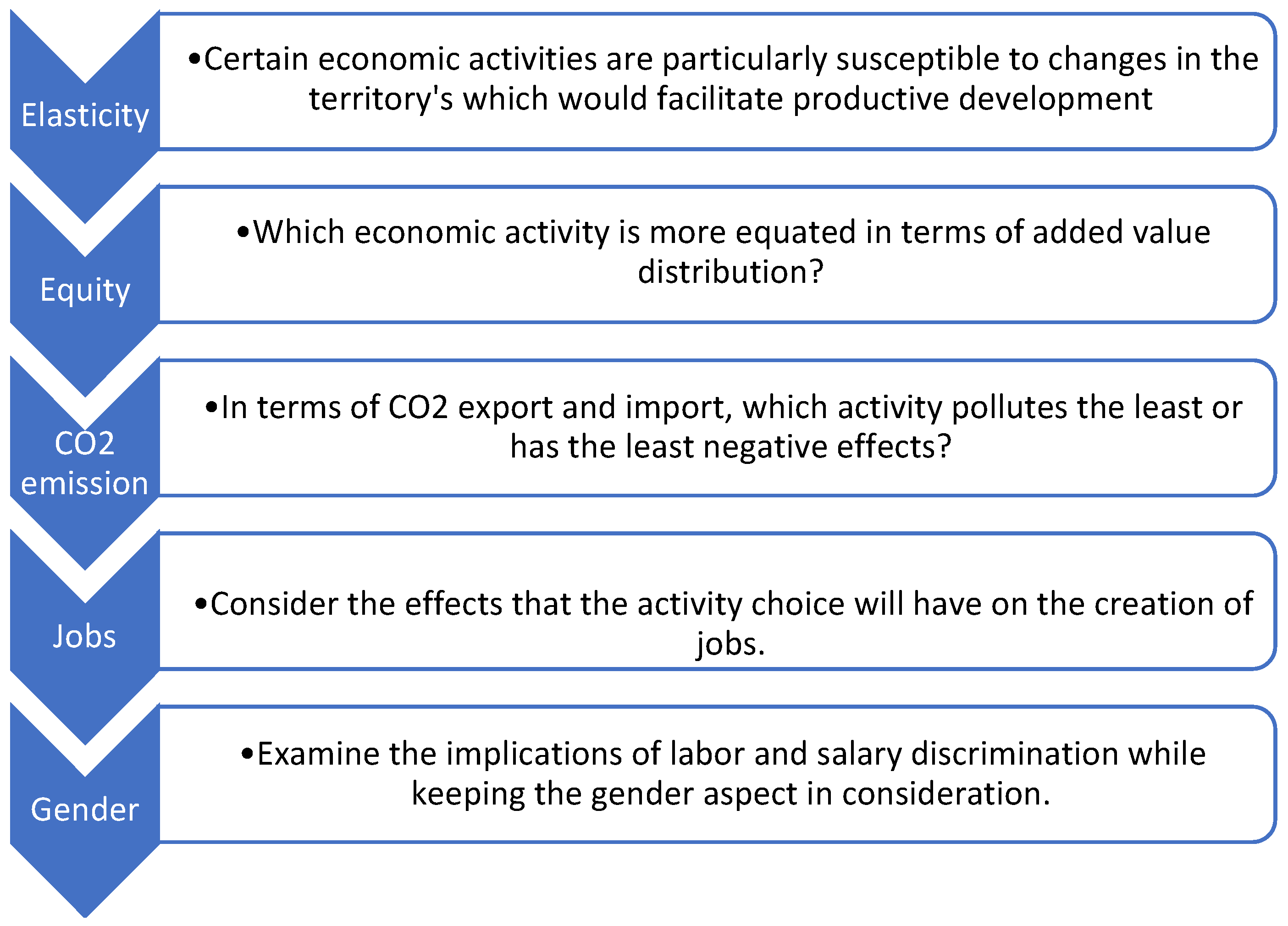
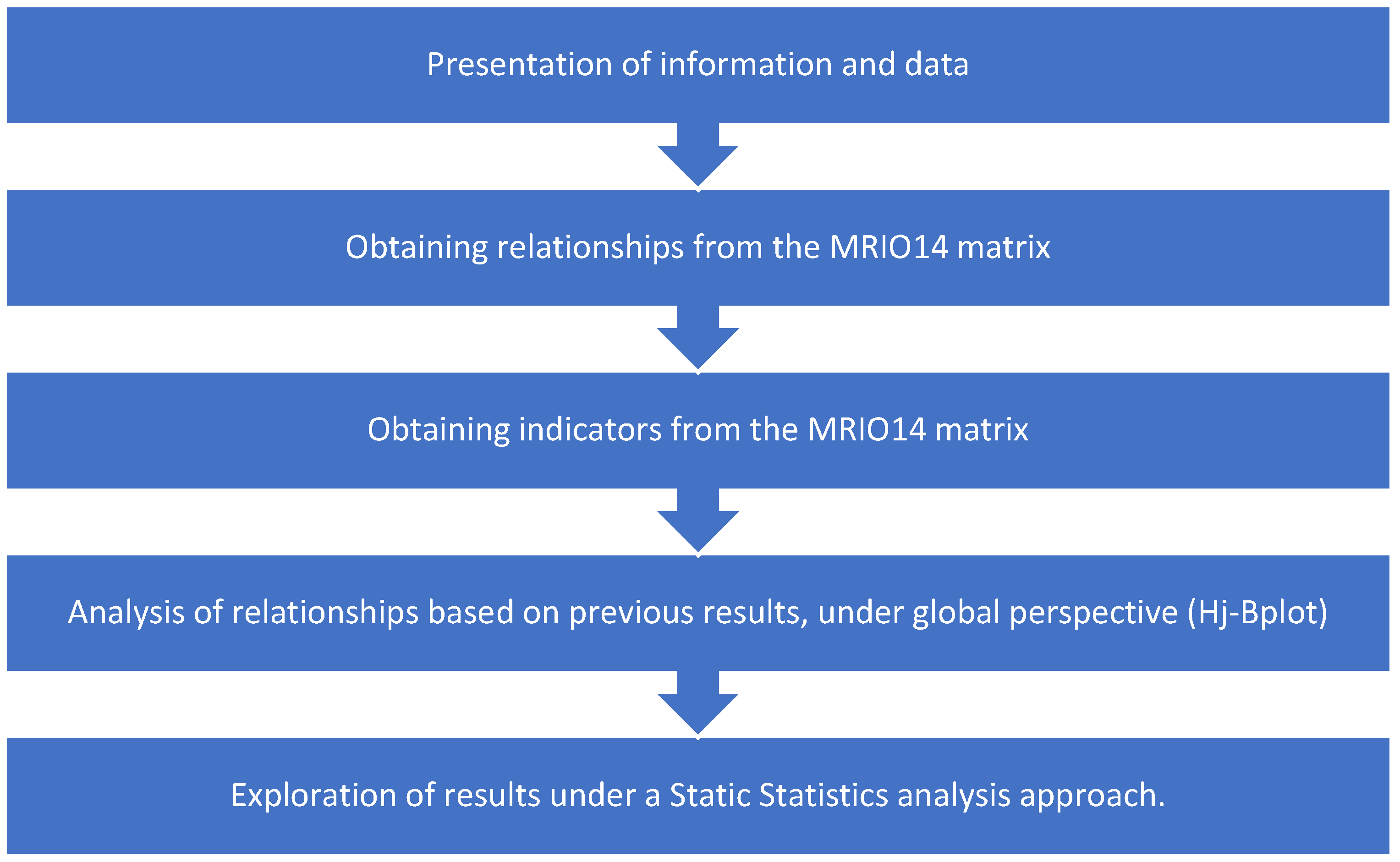
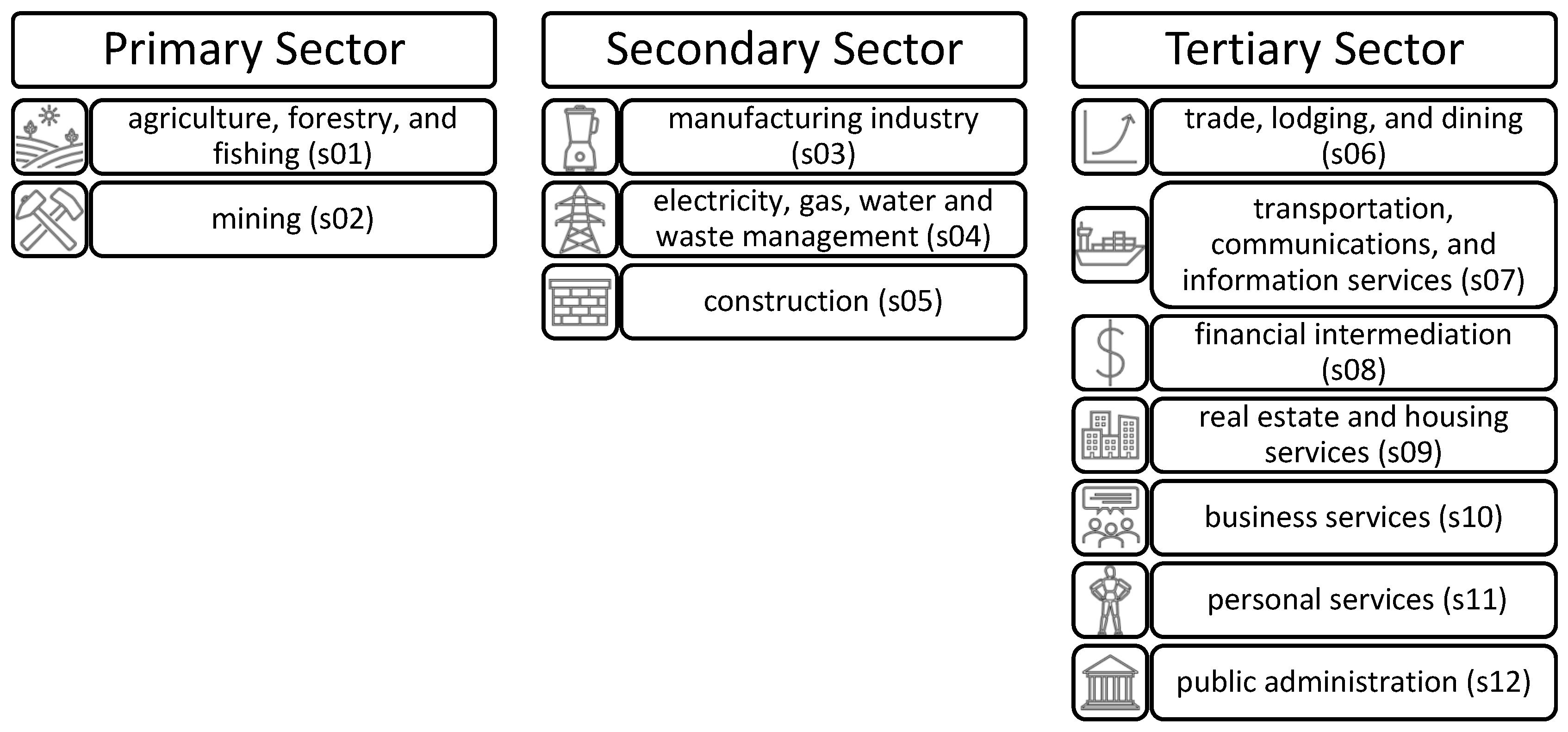
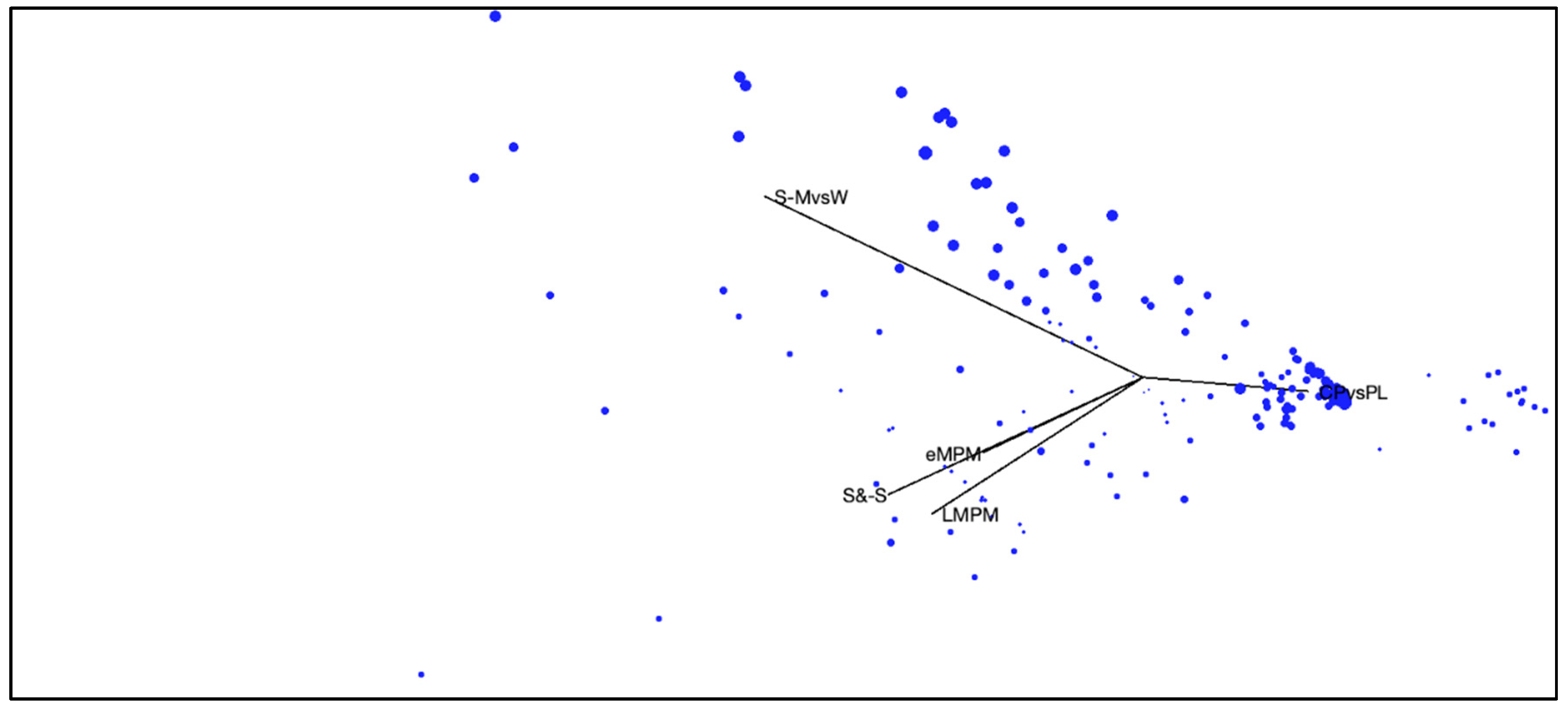
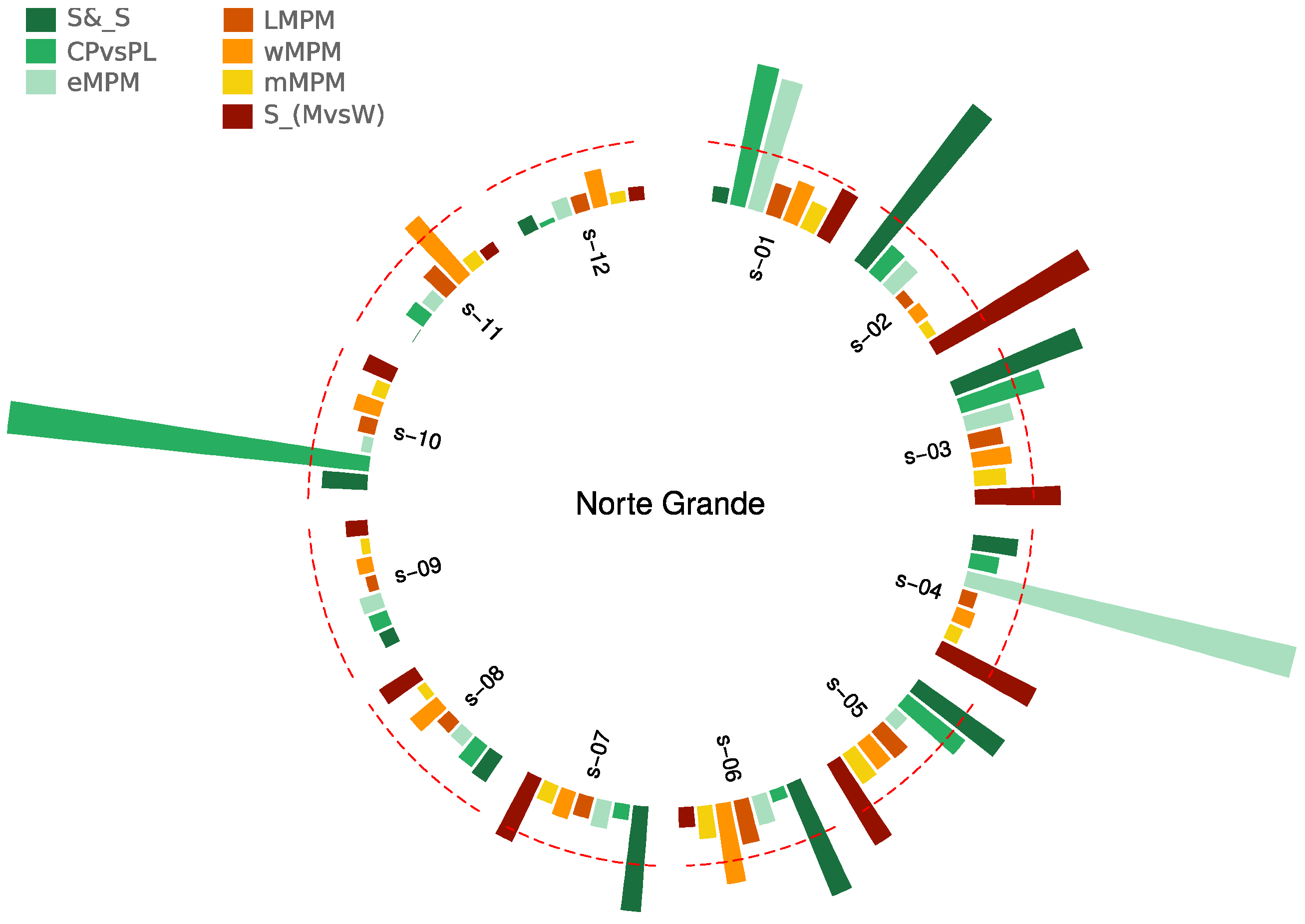
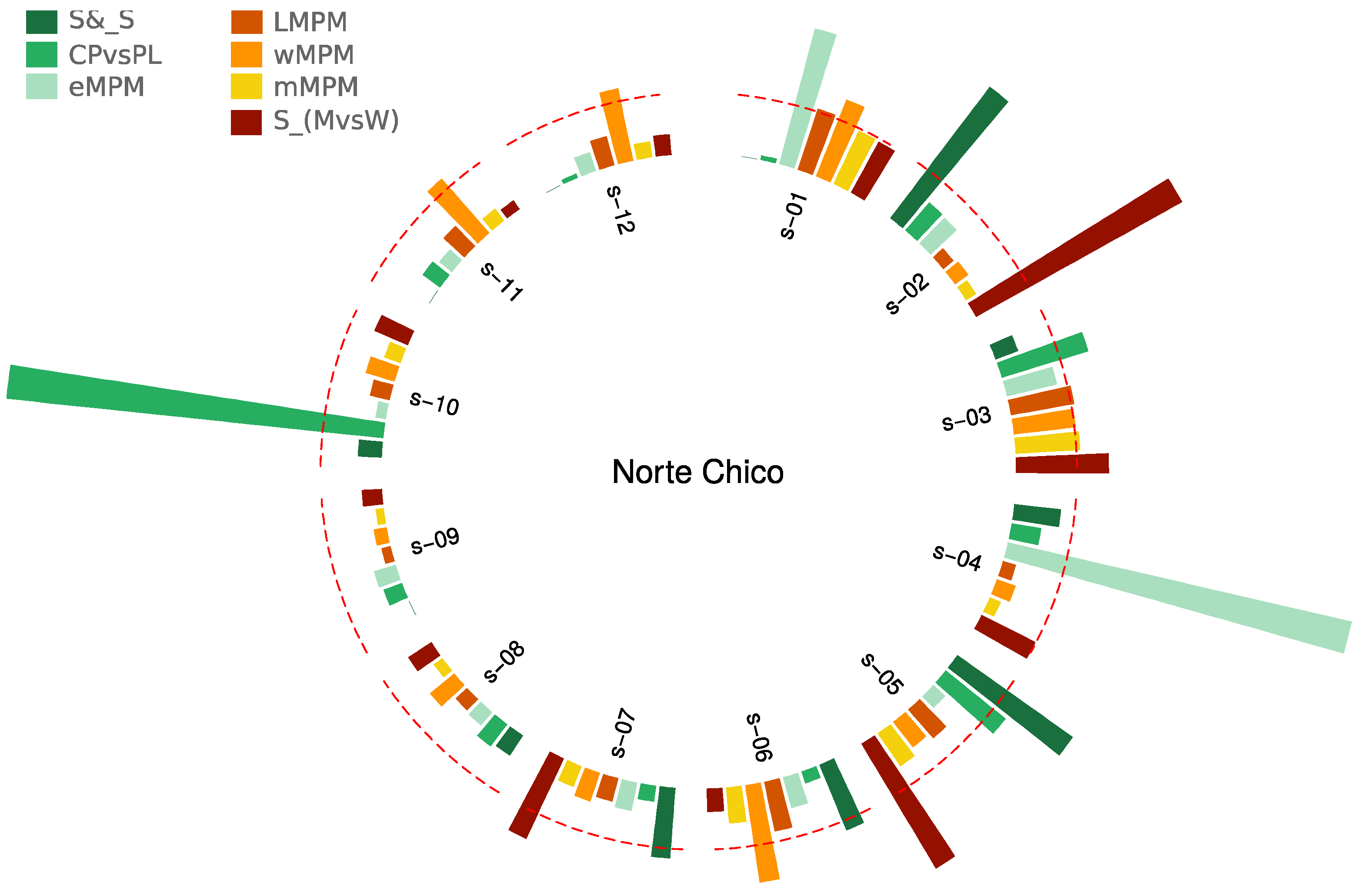
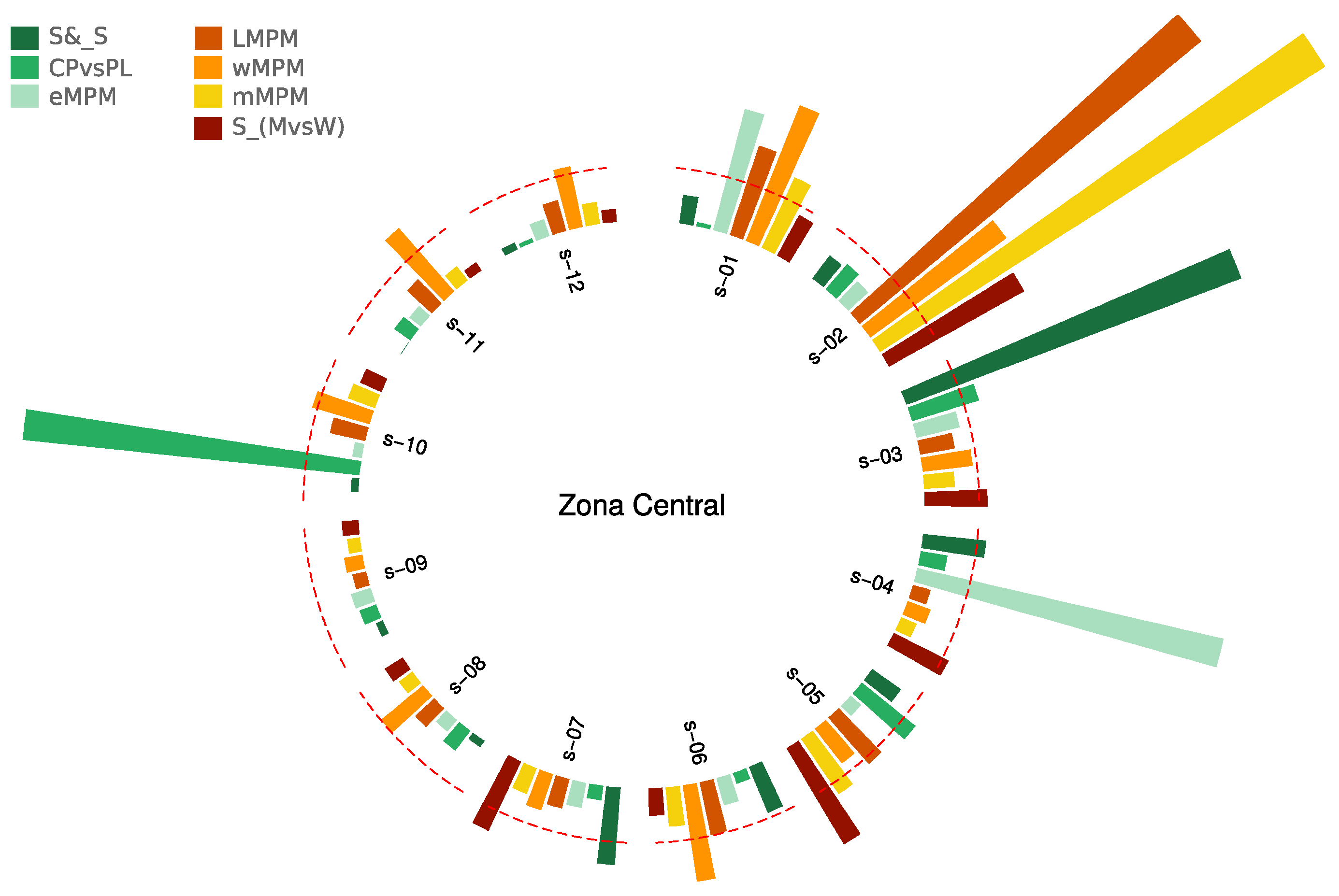

| Average | Standard Deviation | ||||
|---|---|---|---|---|---|
| Variable | Abbreviation | NorteGrande | Norte Chico | NorteGrande | Norte Chico |
| Elasticity | S&S | 1.18 | 0.77 | 1.40 | 1.04 |
| MPM weighted by CO2 | eMPM | 1.01 | 1.01 | 1.56 | 1.58 |
| CapitalPayments/LaborPayments | CP/LP | 1.18 | 0.98 | 1.95 | 1.67 |
| MPM weighted by Labor | LMPM | 0.40 | 0.51 | 0.21 | 0.33 |
| MPM weighted by women | wMPM | 0.64 | 0.76 | 0.42 | 0.51 |
| MPM weighted by men | mMPM | 0.33 | 0.42 | 0.20 | 0.33 |
| Men vs. Women’s salaries | S-MvsW | 1.03 | 1.12 | 0.95 | 1.08 |
| Central Zone | Patagonia | Central Zone | Patagonia | ||
| Elasticity | S&S | 1.02 | 0.95 | 2.34 | 1.44 |
| MPM weighted by CO2 | eMPM | 1.00 | 0.99 | 1.55 | 1.56 |
| CapitalPayments/LaborPayments | CP/LP | 0.96 | 0.93 | 1.65 | 1.66 |
| MPM weighted by Labor | LMPM | 1.34 | 1.19 | 4.58 | 3.60 |
| MPM weighted by women | wMPM | 1.29 | 0.95 | 1.76 | 1.06 |
| MPM weighted by men | mMPM | 1.35 | 1.27 | 5.52 | 4.43 |
| Men vs. Women’s salaries | S-MvsW | 0.95 | 0.99 | 0.84 | 0.90 |
Disclaimer/Publisher’s Note: The statements, opinions and data contained in all publications are solely those of the individual author(s) and contributor(s) and not of MDPI and/or the editor(s). MDPI and/or the editor(s) disclaim responsibility for any injury to people or property resulting from any ideas, methods, instructions or products referred to in the content. |
© 2024 by the authors. Licensee MDPI, Basel, Switzerland. This article is an open access article distributed under the terms and conditions of the Creative Commons Attribution (CC BY) license (https://creativecommons.org/licenses/by/4.0/).
Share and Cite
Soza-Amigo, S.; Doussoulin, J.P. Regional Economic Development, Climate Change, and Work Force in a Gender Perspective in Chile: Insights from the Input–Output Matrix. Sustainability 2024, 16, 8692. https://doi.org/10.3390/su16198692
Soza-Amigo S, Doussoulin JP. Regional Economic Development, Climate Change, and Work Force in a Gender Perspective in Chile: Insights from the Input–Output Matrix. Sustainability. 2024; 16(19):8692. https://doi.org/10.3390/su16198692
Chicago/Turabian StyleSoza-Amigo, Sergio, and Jean Pierre Doussoulin. 2024. "Regional Economic Development, Climate Change, and Work Force in a Gender Perspective in Chile: Insights from the Input–Output Matrix" Sustainability 16, no. 19: 8692. https://doi.org/10.3390/su16198692
APA StyleSoza-Amigo, S., & Doussoulin, J. P. (2024). Regional Economic Development, Climate Change, and Work Force in a Gender Perspective in Chile: Insights from the Input–Output Matrix. Sustainability, 16(19), 8692. https://doi.org/10.3390/su16198692






